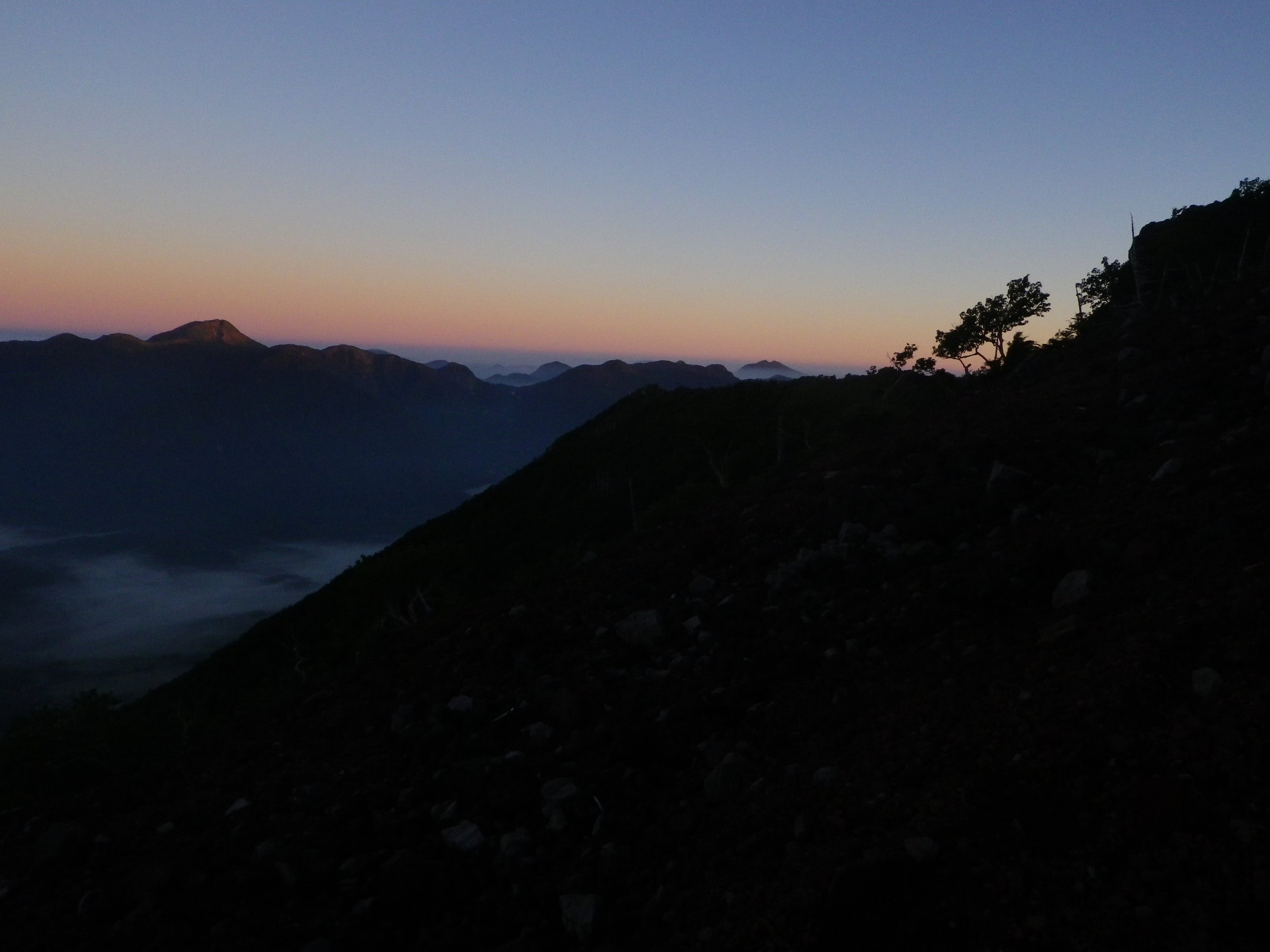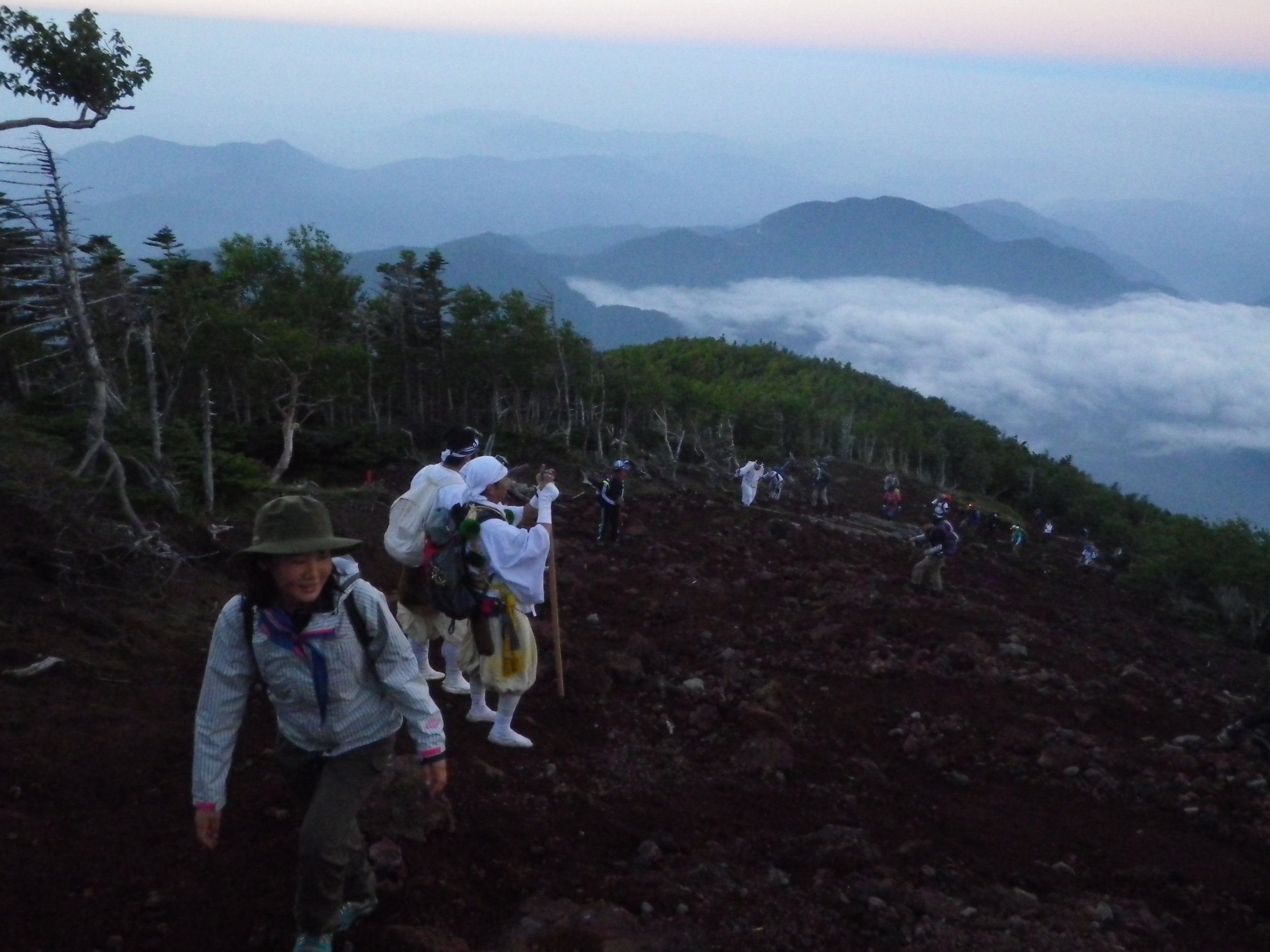Hiking Volcanoes in a Country Where Mountains are Religion
Watching the sunrise from Mt. Nantai
Back in July, I visited Japan for a week to visit my elderly grandparents, but was able to slip away from family obligations at night. Instead of hitting the karaoke bar, my sister, cousin and I went to climb Mt. Nantai, an active stratovolcano and the tallest of the Famous 100 “peakbagger’s list” in the Canto region.
Mt. Nantai rises more than 4,000 feet from the plains.
Nantai-san is considered a holy mountain and is guarded by Shinto monks who close off the trail all year—until midnight on August 1st (in fact, I had tried climbing this mountain several years ago and was thwarted due to the monks’ regulation). Shinto is an ancient religion that, among other things, reveres nature and finds gods—big and small—in the outdoors.
The climb begins with a ritual to wash your hands before visiting the gods. Image courtesy Kat Thomas
I expected that the three of us would be among the only people who would climb Mt. Nantai at midnight as soon as the gates opened. After all—how many people really want to climb 4,000 feet over 3 miles in the middle of the night???
A monk guards the gate to the trailhead.
1500 people! Shinto still informs some Japanese consciousness and that is why the annual opening of Mt. Nantai—the highest peak in the same region as Tokyo—was a big deal. The town of Nikko where my grandparents live, is booming with UNESCO world heritage sites and areas of historic and cultural significance that everyone in Japan learns about in school. On top of that, but the opening coincided with a full moon. Old, young, and middle-aged, we crowded by the closed trailhead gate, waiting for hours in line on the shores of Lake Chuzenji (the highest alpine lake in Japan).
Shobo tried to ford *that* river!
According to legend, in 766 AD, a priest named Shōdō climbed Mt. Nantai to pray for the country’s prosperity. The peak itself, the shrine at the base of the climb (aka “the trailhead”) and a UNESCO world-heritage shrine down the mountain in the town of Nikko all are connected by that monk’s climbing story (he had some trouble with a ford that a god ended up helping him on by building a sweet bridge).
Traditional musicians sing from an elevated platform as part of the pre-hike festivities.
At midnight, the monks struck the gong and the first wave of 100 people went through. A priest blessed them. Then, in a line that recalled childhood visits to Disneyland, or more recent visits to some Denver brunch spots, we slowly ascended a steep stone staircase.
Lanterns at the shrine at the bottom of the mountain.
The hike itself is broken into 8 different stages. Separating the stages are break areas. Monks dressed all in white were spaced out along the route to offer encouragement and help for those in need. Between the first and second stage, there is a wooden miniature shrine. From there, the trail becomes an Appalachian/Long Trail-esque dirt and root path in the woods.
The 3rd wave crowd bursts towards the trail
The third stage is marked by a paved road, which we followed up via switchbacks until we came upon food and drink carts set up particular for the mountain-opening festival. After a snack, we headed up to 4th stage: the steepest part of the trail—a rock climb that recalled the White Mountains of New Hampshire. This climbing was particular difficult in the dark and done while waiting for others. Nonetheless, I felt good about “going as fast as I could” but not leaving my little cousin in the dust.
Buta niku jiru, or pork soup, was a salty treat half way up. Only 100 yen! (less than a dollar). Image courtesy Kat Thomas
Covered shelters mark the cut-offs between the 6th to 8th stages. Although you could certainly sleep in these in an emergency, they were pretty dingy.
The alpine area lit by moonlight and early morning glow
After the 8th stage, the trail became dirt again and became less steep. Once we hit treeline, the hike became fantastic, though, and the type of hike I rarely get to do in Colorado and that makes hiking in Japan such a hoot for me.
We walked on loose volcanic soil—red, black, yellow and grey. The paths were lined with funky rock formations. And the top of the mountain was home to shrines. The true summit of the peak had a large katana on the top of the mountain, although there was a huge summit area replete with a ramen vendor (which I took advantage of) and additional shrines. Although it was warm enough to hike the trail in a t-shirt and 1.5 oz Montbell windshirt (Japan, afterall is fairly tropical), the summit was cold enough that my cousin started shivering and we all pulled out our hats and down.
My little cousin ascending the loose volcanic soil
One of the coolest parts of the hike was walking alongside actual pilgrims—students training for their mountain monk qualifications (as it was explained to me in dumbed down Japanese). These pilgrims were dressed all in white and gathered together to the shrine on top to pray and blow a ceremonial horn. This practice has been going on for centuries. Its inspiring to think that while we may think making lists of mountains you want to climb (called “peakbagging” by some) is actually an ancient affair practiced by many cultures.
The summit katana! Image courtesy Kat Thomas
As a hiker, there is something so powerful about knowing that climbing mountains and witnessing the gods underneath them is something that people have done for centuries. There’s such power in knowing that even hundreds of years ago, people knew the more mountains you climb and the more time you spend in nature, the closer you become to wisdom and spirituality. That an entire country could see the value of time in the outdoors and even find a little wisdom from the experience is a miracle.
The gate when not guarded by monks at midnight, looses some of its creepy/mystical charm
So for those reasons, I’ll forgive the crowds. I’ll thank them for the awesome miso soup I had half way up the mountain. And I’ll return to the US, happy to see some wild places with no ramen on the summit, too.















